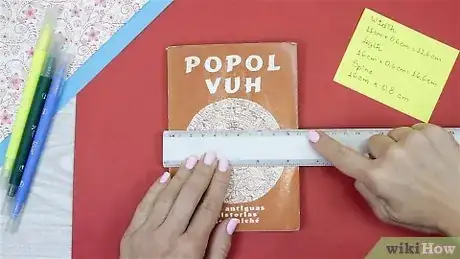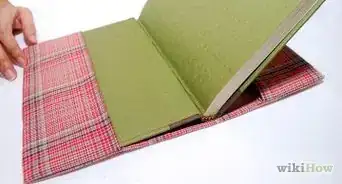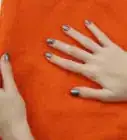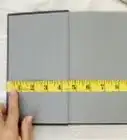This article was co-authored by Lois Wade and by wikiHow staff writer, Luke Smith, MFA. Lois Wade was a high school librarian for four years. She is experienced in repairing books, resewing bindings, and protecting books, along with general book care and organization.
There are 12 references cited in this article, which can be found at the bottom of the page.
This article has been viewed 410,997 times.
It’s downright tragic: your favorite paperback, the one you’ve read a hundred times, is falling apart in your hands. Paperbacks aren’t exactly built to last—hardcovers, on the other hand, tend to have a longer shelf life. If only there was some way to convert that old softcover into a hardcover. Oh, wait. There totally is. We’ve penned a simple guide that’ll show you how to reinforce your paperback and transform it into a strong, durable hardcover book that you can crack it open another hundred times. Are you ready to bind some books?
Things You Should Know
- You can make a hard cover for your paperback book using chipboard and heavy fabric.
- Measure and cut the chipboard to size and glue it to the fabric.
- Use PVA glue to bind the paperback inside its new hard cover.
Steps
Measuring & Cutting
-
1Measure the cover and spine of the paperback. Use a ruler to measure the front or back cover of the book to the nearest millimeter, finding both its length and width, then mark these down. Do the same for the length and width of the spine. Then, add about 6 millimetres (0.24 in) to the length and width values of the front cover’s measurement. This new value will be the length and width of the hard cover’s faces.[1]
- You don’t need to add to the spine’s measurement; this will stay the same.
-
2Trace the new measurements onto some chipboard. Use a ruler to trace the new length and width of the book onto a piece of chipboard (which is the sturdy material often used as back covers for things like sketchbooks—you can also recycle the back of an old sketchbook for this, or buy new chipboard from a craft store). Do this twice: once for the new front cover of your book, and once for the back. Then, trace the spine onto the chipboard.[2]
- You should now have three rectangles traced onto your chipboard: two large rectangles for the front and back, and one skinnier rectangle for the spine.
Advertisement -
3Cut the chipboard to size. Place the chipboard onto a cutting mat, then position a ruler along one traced edge. Use an X-Acto knife or a box cutter to cut along the line, using the ruler as a guide. Repeat this along each line until all three shapes are cut out of the chipboard.[3]
-
4Cut the cover fabric to size. Lay your heavy fabric (use some faux-leather upholstery fabric for that old-book look) flat onto your cutting mat face-down, then lay your open paperback book onto the fabric. Use a pair of scissors to cut the fabric around the shape of the book, leaving about 4 inches (10 cm) of fabric on each side.[4]
- This step doesn’t require exact measurements—we’ll cut the cover fabric down to size a bit later.
-
5Lay the chipboard pieces onto the fabric. Position the three chipboard pieces at the center of your length of fabric, with the spine piece in the center. Leave about 0.25 inches (6.4 mm) of space between each piece, so that the spine will have some room to flex. Then, use a pencil to mark the position of each shape on the fabric.[5]
- The raw or unpatterned side of your fabric should be facing up.
-
6Cut a length of craft paper to span the spine. With a pair of scissors or a box cutter, cut a length of heavy craft paper so that it has the same height as the three pieces of chipboard. Then cut the craft paper so that the width of it spans the spine and overlaps each of the chipboard face pieces by about 1 inch (2.5 cm).[6]
Attaching the Cover
-
1Glue the chipboard to the cover fabric. Apply a generous amount of fabric glue to one side of the first chipboard shape, then press the shape glue-side down onto the fabric in the position you previously marked. Repeat for each shape, until all three lengths of chipboard are adhered to the fabric.[7]
-
2Glue craft paper to the inside cover. Apply a generous amount of PVA glue to the piece of heavy craft paper, the press the craft paper glue-side down into the center of the chipboard pieces, so that the craft paper completely covers the spine, and overlaps each face piece by about 1 inch (2.5 cm).[8]
-
3Trim the cover fabric to size. With a pair of scissors, trim the fabric down so that there’s about 1 inch (2.5 cm) of excess surrounding the outer edges of the chipboard. Then, trim off the four corners.[9]
-
4Fold and glue the edges of the fabric over the chipboard. Apply a generous amount of fabric glue to the raw edges of the fabric. Then, fold each glued edge over onto the chipboard so that the fabric wraps around the chipboard’s edges.[10]
-
5Position the paperback into the new hard cover. Place the spine of the paperback down so that it aligns with the spine of the new cover. Then, fold the new cover flaps so that they close around the book. Check to make sure the new cover fits the paperback: the new cover should be a little larger (about 6 millimetres (0.24 in)) than the book itself. Compare it to an existing hardcover book to get a rough idea of how it should look.[11]
- If your new cover is too small or doesn’t close around the paperback, you may have to restart, this time leaving more room between the chipboard pieces for the spine to flex.
-
6Glue the paperback into its new binding. Generously coat the back cover of the paperback with PVA glue, then press it down onto the back cover of the new binding, positioning it so that its inner, spine-side edge aligns with the inner edge of the back piece of chipboard. Then, apply PVA glue to the front cover, and press the new cover down onto the paperback.[12]
- Don’t glue the spine into the new cover. You’ll want to leave this free and unglued so that it can bend and flex as you open and close the book.
- If your paperback is missing a cover, you can also glue the first exposed pages into the new binding.
-
7Let your new hardcover book dry overnight. Place the book on a flat surface, and cover it with a clean rag or a paper towel. Then, place a heavy object, like a paperweight or a heavy book, on top of it. Leave it to rest overnight so that the glue dries completely.[13]
-
8Decorate your new hardcover book. If you like, you can use PVA glue or fabric paints to fasten decorative pieces to the new hard cover, or write the name of the book on the front face and along the spine.[14]
Community Q&A
-
QuestionHow can I get the spine to stay put if I am making a book?
 Community AnswerI'd suggest using some binder clips to hold down one side of the book at a time. You can get them at Walmart or Office Depot for a couple of bucks. You can also use the larger binder clips to stretch the spine out a little bit. Just open up to the middle of the book and center the clamp along the top of the spine and the bottom of the spine so that the outer spine and the crease are in between the binder clip. This will hold the book open and make the paperback's spine less rigid.
Community AnswerI'd suggest using some binder clips to hold down one side of the book at a time. You can get them at Walmart or Office Depot for a couple of bucks. You can also use the larger binder clips to stretch the spine out a little bit. Just open up to the middle of the book and center the clamp along the top of the spine and the bottom of the spine so that the outer spine and the crease are in between the binder clip. This will hold the book open and make the paperback's spine less rigid. -
QuestionIs there a way to put a hard cover on a book that doesn't have a cover?
 Community AnswerYes. Do some research on bookbinding. You'll find many ways to make a new cover for a coverless book.
Community AnswerYes. Do some research on bookbinding. You'll find many ways to make a new cover for a coverless book. -
QuestionCan I use extra layers of the cereal box cardboard to make the cover thicker?
 Community AnswerYes, you can, this will give your book added protection.
Community AnswerYes, you can, this will give your book added protection.
Things You’ll Need=
- Chipboard
- Craft paper
- Heavy fabric
- Fabric glue
- PVA glue
- Ruler
- X-Acto knife or box cutter
- Cutting mat
References
- ↑ https://www.youtube.com/watch?v=wx498b31kfA&t=870s
- ↑ https://www.youtube.com/watch?v=wx498b31kfA&t=870s
- ↑ https://www.youtube.com/watch?v=wx498b31kfA&t=870s
- ↑ https://www.youtube.com/watch?v=x4NPaFm2v5g&t=96s
- ↑ https://www.youtube.com/watch?v=x4NPaFm2v5g&t=183s
- ↑ https://www.youtube.com/watch?v=x4NPaFm2v5g&t=216s
- ↑ https://www.youtube.com/watch?t=120&v=x4NPaFm2v5g&feature=youtu.be
- ↑ https://youtu.be/x4NPaFm2v5g?t=215
- ↑ https://www.youtube.com/watch?v=x4NPaFm2v5g&t=267s




















































